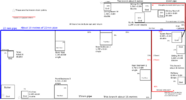Hi,
I need to run some new copper central heating pipe 15mm from the manifold to new radiators in an extension, the run to the first rad could be up to 8m and to the next possibly 12m - is it too far away? What is the longest the combi boiler could push around the system without degrading performance too much?
The pipes will be hooked up to two quite large radiators.
Thanks
I need to run some new copper central heating pipe 15mm from the manifold to new radiators in an extension, the run to the first rad could be up to 8m and to the next possibly 12m - is it too far away? What is the longest the combi boiler could push around the system without degrading performance too much?
The pipes will be hooked up to two quite large radiators.
Thanks



